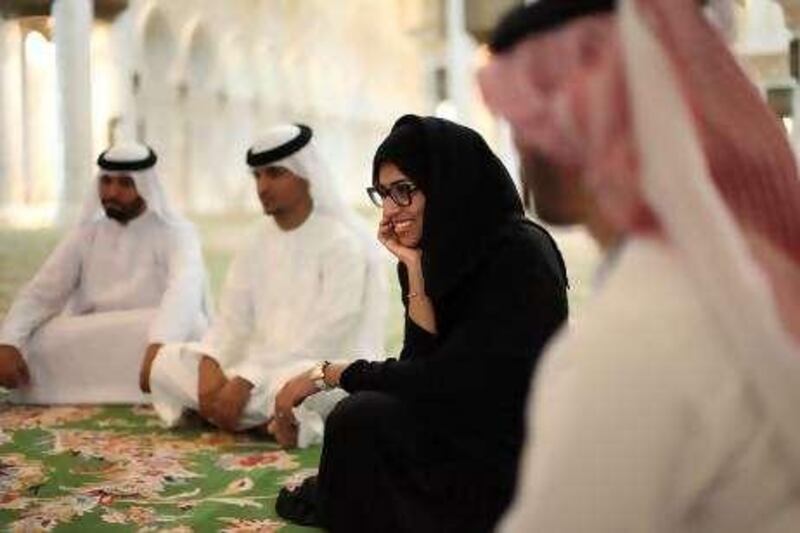ABU DHABI // For Muslims across the world, the mosque will be a second home during Ramadan. And visitors to the Sheikh Zayed Grand Mosque will enter a place that is bridging cultures, where devoted young Emirati tour guides show them around and answer their religious and cultural questions.
"For many of the visitors here, it is their first-ever direct contact with an Emirati where they can actually ask questions they have about our culture and religion," said Maitha Abdulrahman, 21, a business student and part-time tour guide at the mosque. Much of the time she and her colleagues explain the significance of different architectural elements at the mosque. For example, there are carved grape vine leaves along the building's pillars because grapes were mentioned in the Quran as one of the fruits in heaven, and that the golden prayer niche, or al Mahreb, from which the imam leads prayer, was inspired by the rivers of honey in heaven.
But the guides also often find themselves asked more personal questions about their traditional dress, the kandoura and abaya, or social conventions such as marriage. "We wear black, as it is modest and covers well what we wear under it, and in the pre-oil area, it was made from the most affordable material here," said Ms Abdulrahman, who is from Khor Fakkan. "We explain to them that the men wear white, as traditionally they spent their days out in the sun either in the desert or fishing, and it was important to be dressed in light and visible material."
Ms Abdulrahman is one of 25 Emirati tour guides from across the UAE giving visitors to the mosque complimentary tours. The tours normally begin at 10am, and take place from Saturday through Thursday, but during Ramadan they will begin at 11am during Ramadan. The tour guides, most of whom are students, explain to visitors the significance of the mosque and discuss its architectural elements. In addition, they will tell tourists and visitors about the traditions of Ramadan.
As part of the holy month, iftar tents will be set up outside the mosque for less fortunate members of society, particularly labourers. About 17,000 people will be given iftar daily. In addition, the Imam's call to prayers in this mosque will be broadcast to all other mosques in Abu Dhabi. Besides having an opportunity to help break down social barriers, Ms Abdulrahman takes comfort in being near the grave of the late Sheikh Zayed, founder of the nation, after whom the mosque was named. It is located just outside the main mosque, in a simple white structure.
At the site, two mams recite the Quran in two-hour shifts, with breaks for prayers. The grave remains off limits to the public; only the Sheikh's family is allowed to visit it. "I send prayers upon his soul every time I pass by his grave," Ms Abdulrahman said. For other guides, working at the mosque is a chance to spend their time in a "serene" place, something they say makes their job special. "We usually just go to the mosque for specific prayers and go home, but this way, I get the chance to really appreciate the mosque and understand it better and how much history there is in each of its sections," said Mohammed al Hashimi, 23, a student from Al Ain who is studying electric engineering.
Mr al Hashimi especially enjoys walking in the white marbled courtyard at night, watching how the lighting plays in a space large enough to hold 22,000 worshippers. "The mosque is surrounded by palm trees in the same way like an oasis, where people come to relax and take refuge from their hectic life and the merciless sun," he said. "In Ramadan, we are reminded of the mosque's place in our religion and how it is more than just a place of worship. It is also a place of gathering and uniting."
"Ever since I have become a guide, I get random people coming up to me in the supermarket and greeting me as Mohammed from the mosque," said Mohammed Abdullah, 22, a student from Abu Dhabi who is studying project management. "I feel great about being able to bridge some of the misunderstanding between us and the expat community, as well as visitors from abroad," said Mr Abdullah, who was taken on a tour of a church in Abu Dhabi by a group he guided through the mosque.
"I learned there are similarities between places of worship, and at the same time there are differences, and it's important to understand them and respect them," he said. One mainstay at the mosque is photography; almost all visitors want to have their picture taken amid the splendid architecture combining Persian, Indian, Turkish, Moroccan and Egyptian styles, the seven chandeliers featuring one million Swarovski crystals, and what is billed as the world's largest hand-woven prayer carpet, hand-knotted by 1,200 weavers in Mashhad, Iran. And they often ask to pose with the guides.
"They always ask us if it is OK to take a picture with us," said Mr Abdullah. "It is great, as we have posed with people from across the world." rghazal@thenational.ae






